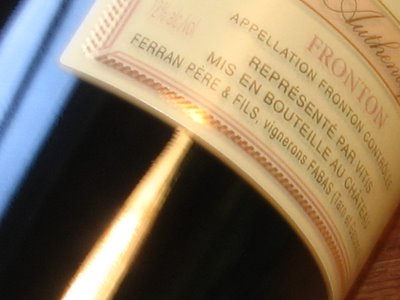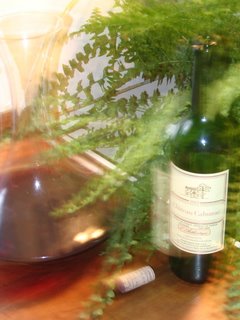WBW #30 New World Syrah/Shiraz: Chile's Errazuriz Estate 2005, Australia's Jacob's Creek 2004 and a California Pastiche

For this month's WBW theme, brilliantly resurrected by Tim at Winecast (who is always ready for for a WBW throwdown -- good job organizing Tim!), I wanted to taste more than just one rendition of New World Syrah.
Why? Well, I don't usually drink much New World wine, and certainly not its version of the Syrah grape, which in Australia is infamously known as Shiraz. Because I'm inexperienced with all but the Aussiest of versions, I wanted to try to cover all the bases and not come out of the event making a snap judgment.
So I tried for three, got confirmation that at least two of the bottles were majority Syrah, and then from there took away one solid winner.
First, let me introduce the third wine, the also-ran, which ended up seeming to be ineligible for this event. It is the Joseph Phelps Vin du Mistral Red Pastiche 2005 (see image at lower right).
The 2005 vintage of Pastiche is mostly Grenache and Syrah with some Cabernet Sauvignon and Merlot. The exact figures aren't released. I even tried calling the Phelps 1-800 number to get closer to the details on this wine, but no luck. The stuff lives up to its "table wine" vagaries, and I can respect that. Suffice to say, the Syrah can't reach 51% of the composition of this wine -- what with Grenache being listed as the first ingredient and then two other grapes added into the mix. Yet the Syrah does stake its claim in this winning blend, which is quite reminiscent of a fine Rhône cuvée. It is a dignified and delicious dinner wine (it goes beautifully with Jacques Pépin's roast chicken, which is a meal I posted about just a couple of days ago). This Pastiche possesses all the smokiness and bite that a great Syrah would.
In Quebec (where I write from) Red Pastiche has a new lower-than-ever price -- some three dollars less than the LCBO in Ontario, which is a coup. And now that it is under $20 (Canadian dollars, that is) this wine is both a great value and an impressive offering. Nothing short of a great Californian example of robust viticulture and ingenious winemaking.
Speaking of fantastic wine at attractive pricepoints, witness the first bottle you see at the top of this post. It is the Errazuriz Estate Shiraz Valle de Rapel 2005. Buy this wine!
If what Errazuriz produces can showcase great dimension and a nice viscosity in an affordable Shiraz, Jacob's Creek on the other hand makes a wine that washes down too much like water. Jacob's Creek Shiraz/Cabernet South Eastern Australia 2004, pictured second at the top of the post, is only $1 less than its Chilean counterpart. You will want to fling that buck you save right out the window.
This blend of at least 51% Shiraz does get better with aeration but that is about all I can say in its defense. I tried to put this wine through its paces and it tasted like grape juice in the face of the above. Light to medium body with little in the form of real personality. And that is a shame because I've tried the 100% Shiraz varietal from Jacob's Creek and it holds its own. Perhaps I could refer readers to that post and in so doing end this entry for WBW #30 on a positive note.
That is what WBW #30 deserves, because in my mind, this installment has been a really striking topic and one that an Old World wino like me finds rife with interest, surprise and tremendous wine value!
Viña Errázuriz, Santiago, Chile. 14%; Rowland Flat (South Australia), Australia. 13.5%.









